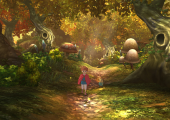Wolverine is a second-division, third-generation Marvel superhero, and for all the care devoted to his sixth cinema outing, he remains the problem here. First introduced in 1974, Stan Lee and Jack Kirby – comics’ Lennon and McCartney – were no longer on hand to conceive this metal-clawed lunk with the adolescently resonant weaknesses they gave Spider-man and the rest. Instead, Wolverine had over-wrought, tin-eared Chris Claremont to chronicle his key years as the star turn in the X-Men, a firm fan favourite who never touched the general public.
This second attempt at a solo film away from the X-Men franchise is based on a 1980s mini-series by Claremont and Frank Miller, which landed Wolverine in Japan, and Miller’s favoured milieu of samurai, ninjas, codes of honour and gut-opening swordplay. The capable, stylish director James Mangold exploits this setting for all its worth, aiming for a “fever dream” of modern Japan, mixing ancient warriors and industrialists, and bullet-training from Tokyo to the rustic, lazing south.
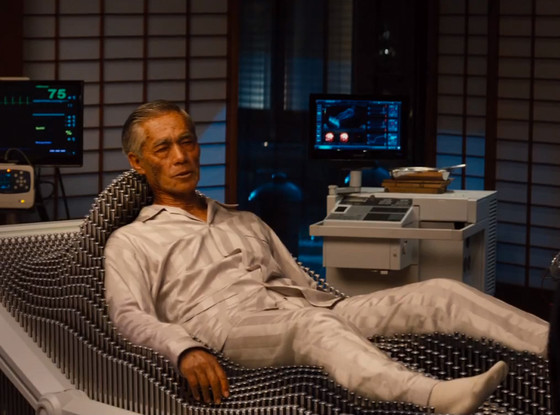 He opens with the Atom bomb blasting Nagasaki, where the immortal, indestructible Wolverine (Hugh Jackman) saves a young Japanese soldier. In the present day, that soldier has become dying industrialist Lord Yashida (Haruhiko Yamanouchi, pictured right). Drawing a drifting Wolverine to his death-bed, he tells him that the immortality which has come to seem like a curse can be extracted and transferred to another. After a mass Yakuza assault on Yashida’s funeral, Wolverine rescues the industrialist’s grand-daughter and heir Mariko (Tao Okamoto, pictured below with Jackman), going on the run together across Japan. Finding his indestructibility has indeed been removed, our hero is bloodied, wounded, vulnerable: about as interesting as he’s ever been.
He opens with the Atom bomb blasting Nagasaki, where the immortal, indestructible Wolverine (Hugh Jackman) saves a young Japanese soldier. In the present day, that soldier has become dying industrialist Lord Yashida (Haruhiko Yamanouchi, pictured right). Drawing a drifting Wolverine to his death-bed, he tells him that the immortality which has come to seem like a curse can be extracted and transferred to another. After a mass Yakuza assault on Yashida’s funeral, Wolverine rescues the industrialist’s grand-daughter and heir Mariko (Tao Okamoto, pictured below with Jackman), going on the run together across Japan. Finding his indestructibility has indeed been removed, our hero is bloodied, wounded, vulnerable: about as interesting as he’s ever been.
Mangold is responsible for surprising and entertaining turns in the careers of Sylvester Stallone (Cop Land), Angelina Jolie (Girl, Interrupted), Russell Crowe (3.10 to Yuma), Joaquin Phoenix (Walk the Line) and John Cusack (Identity), and has worked with Hugh Jackman before, on the Meg Ryan romance Kate and Leopold. He brings out his star’s easy, straightforward decency and muscular charisma, and sets him to work in what for much of its more than two hours is a modern film noir, with a haunted knight errant as its hero. Okamoto is also excellent, woefully under-written but communicating great depth, as does Yamanouchi, fearsomely steely and calculating even as his character lies dying. There are some extraordinary images too, such as Wolverine’s harpooning by dozens of ninja arrows, straining but reeled in to a backdrop of mountain snow.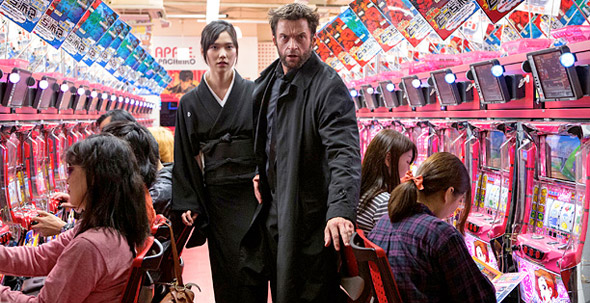 The moment when all this good work unravels is easy to spot: it’s when Wolverine regains his indestructibility. When a hero instantly heals after his opponent hits his heart fair and square with a sword, you start to side with the hapless bad guys. The final reel is schematic and battle-heavy, full of obvious revelations and the over-heated, unconvincing pulpiness of a typical 1970s Marvel comic. Basically, it becomes another Wolverine yarn, and the energy and talent expended to find something worthwhile in that falls exhausted to the floor. It’s enjoyable, even memorable. But comic-book lead can’t be turned into gold.
The moment when all this good work unravels is easy to spot: it’s when Wolverine regains his indestructibility. When a hero instantly heals after his opponent hits his heart fair and square with a sword, you start to side with the hapless bad guys. The final reel is schematic and battle-heavy, full of obvious revelations and the over-heated, unconvincing pulpiness of a typical 1970s Marvel comic. Basically, it becomes another Wolverine yarn, and the energy and talent expended to find something worthwhile in that falls exhausted to the floor. It’s enjoyable, even memorable. But comic-book lead can’t be turned into gold.
Overleaf: watch the trailer to The Wolverine


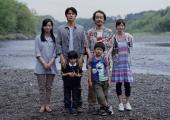

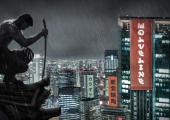
 He opens with the Atom bomb blasting Nagasaki, where the immortal, indestructible Wolverine (Hugh Jackman) saves a young Japanese soldier. In the present day, that soldier has become dying industrialist Lord Yashida (Haruhiko Yamanouchi, pictured right). Drawing a drifting Wolverine to his death-bed, he tells him that the immortality which has come to seem like a curse can be extracted and transferred to another. After a mass Yakuza assault on Yashida’s funeral, Wolverine rescues the industrialist’s grand-daughter and heir Mariko (Tao Okamoto, pictured below with Jackman), going on the run together across Japan. Finding his indestructibility has indeed been removed, our hero is bloodied, wounded, vulnerable: about as interesting as he’s ever been.
He opens with the Atom bomb blasting Nagasaki, where the immortal, indestructible Wolverine (Hugh Jackman) saves a young Japanese soldier. In the present day, that soldier has become dying industrialist Lord Yashida (Haruhiko Yamanouchi, pictured right). Drawing a drifting Wolverine to his death-bed, he tells him that the immortality which has come to seem like a curse can be extracted and transferred to another. After a mass Yakuza assault on Yashida’s funeral, Wolverine rescues the industrialist’s grand-daughter and heir Mariko (Tao Okamoto, pictured below with Jackman), going on the run together across Japan. Finding his indestructibility has indeed been removed, our hero is bloodied, wounded, vulnerable: about as interesting as he’s ever been. The moment when all this good work unravels is easy to spot: it’s when Wolverine regains his indestructibility. When a hero instantly heals after his opponent hits his heart fair and square with a sword, you start to side with the hapless bad guys. The final reel is schematic and battle-heavy, full of obvious revelations and the over-heated, unconvincing pulpiness of a typical 1970s Marvel comic. Basically, it becomes another Wolverine yarn, and the energy and talent expended to find something worthwhile in that falls exhausted to the floor. It’s enjoyable, even memorable. But comic-book lead can’t be turned into gold.
The moment when all this good work unravels is easy to spot: it’s when Wolverine regains his indestructibility. When a hero instantly heals after his opponent hits his heart fair and square with a sword, you start to side with the hapless bad guys. The final reel is schematic and battle-heavy, full of obvious revelations and the over-heated, unconvincing pulpiness of a typical 1970s Marvel comic. Basically, it becomes another Wolverine yarn, and the energy and talent expended to find something worthwhile in that falls exhausted to the floor. It’s enjoyable, even memorable. But comic-book lead can’t be turned into gold.




